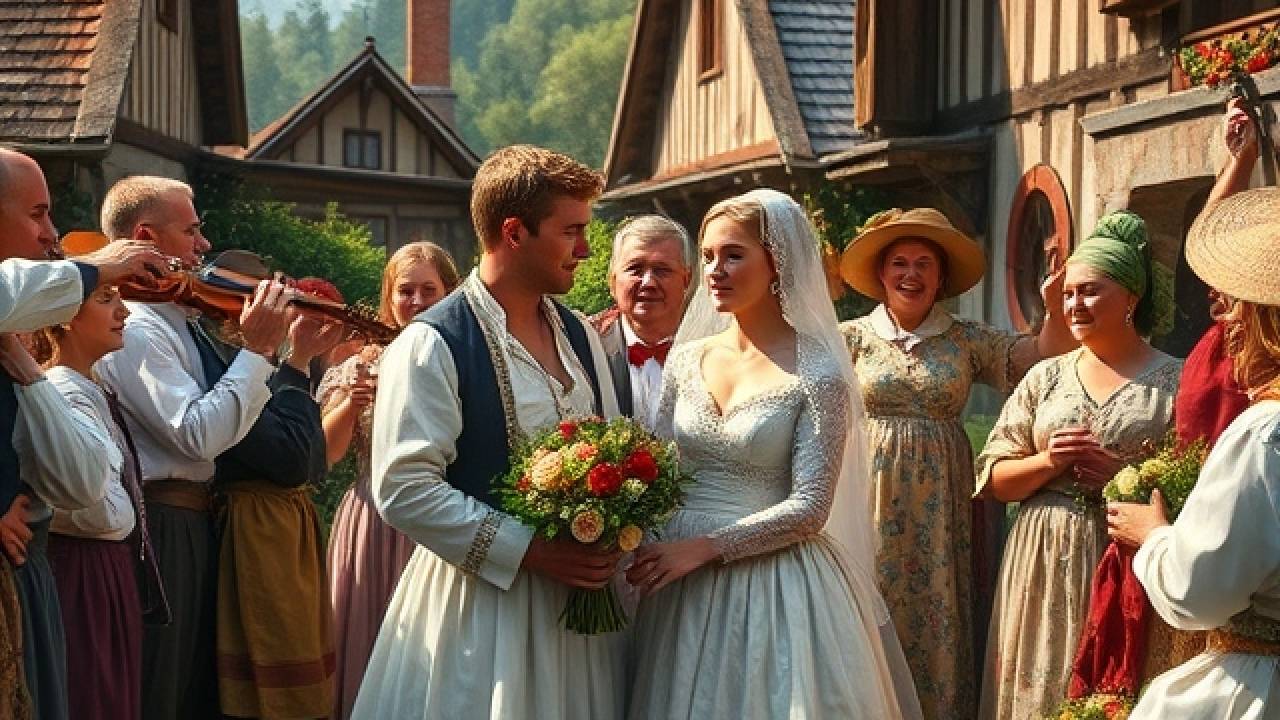In a quiet town brimming with stories, the union of Eanest Weed Alma Schmaus Marriage stands out not just for its personal significance but also for the cultural impact it holds. Some might recall their wedding as a reflection of a bygone era, encapsulating traditions that are fading in contemporary society. The Eanest Weed Alma Schmaus Marriage is often cited for its embodiment of love forged through intellectual partnership and shared community commitments.
The historical context of Eanest Weed Alma Schmaus Marriage provides a fascinating glimpse into societal expectations of partnerships during their time. Rooted in shared values and ambitions, their relationship became a testament to the power of mutual support in achieving personal and collective aspirations. Experts often analyze such unions to understand patterns in familial structures, noting that Eanest and Alma’s collaboration extended beyond personal realms into civic engagement, offering valuable insights into the symbiotic nature of marriage when intertwined with community service.
Eanest Weed and Alma Schmaus’s marriage exemplified a seamless blend of personal commitment and societal engagement, embodying traditions that strengthened community bonds. Their union demonstrated the symbiotic relationship between marital partnerships and civic duties, highlighting both as avenues for nurturing societal progress and cultural preservation within their historical context.
Eanest Weed Alma Schmaus Marriage: A Historical Insight
The Eanest Weed Alma Schmaus Marriage is a captivating tale from history that offers a unique perspective on cultural practices. Their union is celebrated not only for its personal significance but also for how it embodied community values at the time. Historians often look to their story to understand marriage norms and how they evolved over time. The way they navigated societal expectations provides rich material for discussions on historical marriages. It is fascinating how their relationship reflects broader changes in society during their era.
Traditions played a fundamental role in the marriage of Eanest and Alma. These rituals, common during their time, showcased the harmony between individual and community expectations. As they embarked on their marital journey, both families and friends were involved, highlighting the communal aspect of marriage. Lists of customs included ceremonies that united not just the couple, but also linked their wider social circles. The shared experiences at such events strengthened social bonds while setting precedents for future unions.
Social dynamics during the time of Eanest Weed Alma Schmaus Marriage were complex yet significant. Marriages often served to solidify relationships among families and communities. This partnership was no different, demonstrating the blend of personal and public life. Their roles and responsibilities extended beyond personal confines, influencing civic engagements. This interweaving of private and public life played a crucial role in the historical understanding of marital relationships.
Exploring the marriage of Eanest and Alma extends beyond personal narratives; it delves into the heart of community service. They collaborated not only in personal matters but also took active roles in their community. Their partnership was a testament to the impact that united efforts could have. As active participants in civic matters, they contributed to society in meaningful ways. This historical insight offers valuable lessons on the importance of teamwork in both personal life and community service.
The Cultural Significance
The marriage between Eanest Weed and Alma Schmaus holds great cultural significance because it reflects the customs and traditions of their time. Through their union, we see how important family and social ties were. These marriages often acted as bridges, connecting different communities. This cultural exchange deepened relationships and shared knowledge. Eanest and Alma’s marriage symbolizes a rich tapestry of cultural heritage.
Rituals played a critical role in adding depth to their marriage’s cultural importance. Each tradition they followed was a celebration of values passed down through generations. These events marked transitions in their lives and were ringed with festivity and meaning. Elements like music, dance, and attire highlighted the unique cultural features. Such traditions were pivotal in maintaining a sense of identity and history.
In terms of cultural impact, Eanest Weed Alma Schmaus Marriage also influenced societal norms. Their relationship illustrated the importance of balancing personal aspirations with communal responsibilities. They showed how a union could contribute to both family harmony and social progress. As they actively engaged in community matters, they set examples for others. They embodied the idea that personal relationships could also serve a greater good.
The cultural significance extends to how their story is remembered and celebrated today. It serves as a historical lesson and a reminder of the values that shaped their time. Narratives of their marriage inspire current discussions about cultural traditions and heritage. This helps keep such experiences alive, urging new generations to appreciate their roots. Remembering such stories encourages a continuous celebration of cultural diversity and unity.
The Key Elements and Rituals: Weaving a Narrative of Tradition
The Eanest Weed Alma Schmaus Marriage is rich with key elements and rituals that make it a fascinating narrative of tradition. These traditions were significant in tying together not just the couple, but their communities as well. The ceremonies they practiced were full of meaning, reflecting the values of their time. By engaging in these rituals, they honored their ancestors and passed down a legacy. This helps to keep the culture alive over generations.
Several key elements made their rituals distinct and memorable.
- Traditional attire played a vital role in setting the scene, often made from fabrics that told stories of their own.
- Music added an auditory backdrop that resonated with cultural emotions.
- Feasting acted as a shared experience, bringing everyone together in celebration.
Such elements were fundamental in forming the bonds that held the community together. They demonstrated the power of collective experiences in strengthening family ties.
The rituals were not just for the couple but involved everyone, making them communal experiences. People gathered to witness these moments, participating in dances, songs, and ceremonies. These shared experiences were ways to express happiness and togetherness. They also offered a chance for everyone to contribute to the success of the marriage. These activities built a sense of belonging and unity among those involved.
Collectively, the elements and rituals of Eanest and Alma’s marriage highlighted a larger narrative of cultural and traditional significance. Their marriage serves as a reminder of how traditions can narrate stories that resonate through time. It reflects how culture uses these rituals to create narratives that preserve its essence. Sharing stories of these elements fosters a deeper understanding of the traditions. Exploring these narratives enriches knowledge of one’s cultural heritage.
Social Expectations and the Marriage: A Symbiosis of the Personal and Public
The marriage of Eanest Weed and Alma Schmaus was a fascinating blend of personal and public expectations. Marriages during their time often served to connect different families and community groups. This connection was not merely personal; it created alliances that benefited the broader community. Their partnership showed how a marriage could fulfill social roles while maintaining personal commitments. They balanced these expectations with grace.
Public life during their time involved active participation in community events and responsibilities. Alma and Eanest fulfilled these roles, demonstrating dedication beyond their marriage. Their engagement in civic duties made them influential community members. This reflected the significance of personal relationships in broader societal contexts. Their story highlights the link between marriage and social obligation.
Expectations were placed on the couple to exemplify certain societal ideals. This was not unusual; many couples found themselves in similar positions. Their actions were often scrutinized as they were seen as role models. However, they were up to the challenge and inspired others in the community. Their success lay in their ability to lead with authenticity and respect.
Their marriage symbiotically melded personal aspirations with these societal pressures seamlessly. Instead of viewing these as constraints, they turned them into opportunities for growth. The couple managed to foster a nurturing personal environment while contributing publicly. This balance helped them achieve much in their personal and social lives. Eanest Weed Alma Schmaus Marriage showcases an admirable example of balance and harmony.
A significant part of managing these expectations was communication. Clear and honest communication allowed them to navigate personal and social challenges successfully. They learned to listen and adjust according to the situations they faced. This skill enriched their marriage and their public roles. Effective communication proved essential in blending their personal lives with community responsibilities.
Interpreting Marital Partnerships in Historical Context: The Case of Eanest and Alma
Understanding the marital partnership of Eanest Weed and Alma Schmaus requires a look at history. Their marriage wasn’t just about personal happiness; it was deeply interconnected with societal norms of their time. This partnership signifies how marriages served larger roles, extending beyond individual desires. They became examples of relationships that fulfilled both personal and communal expectations. Their marriage offers insight into how historical contexts shape partnerships.
The roles of husband and wife were clearly defined, yet Eanest and Alma managed to transcend the norms. They worked together on various ventures, demonstrating a modern partnership approach. This mutual collaboration is a significant aspect of understanding their dynamic. It shows a blend of traditional roles with progressive cooperation. Their example paved the way for future generations to see marriage as a partnership of equals.
These partnerships often reflected the values held by society at large. For instance, loyalty, responsibility, and support were key components. Tables detailing societal expectations might show how these marriages were viewed as building blocks for community stability.
- Spouses were expected to support each other in social roles.
- They were also encouraged to balance personal growth with family responsibilities.
Aligning personal partnerships with societal needs was typical during their era.
Progression in their partnership was also marked by adaptability to changing times. Alma and Eanest embraced new ideas within their roles, making their partnership resilient. This adaptability allowed them to thrive despite external pressures. Their marriage illustrates how evolving cultural landscapes can impact personal relationships positively. They adapted while preserving key values, showcasing a seamless blend of tradition and innovation.
Their relationship also emphasized the importance of understanding and communication. By sharing goals and visions, they created a supportive environment. This model of partnership serves as an educational tool even today. It highlights how clarity and unity can build strong marriages. Eanest and Alma’s story continues to teach us about the timeless nature of understanding and support within marital partnerships.
Community Service and Marriage: A Look Through Eanest Weed and Alma Schmaus’s Relationship
Eanest Weed Alma Schmaus Marriage exemplified the strong link between community service and personal relationships. Their partnership went beyond personal boundaries, making significant impacts on the community they lived in. Engaging in community service together not only strengthened their bond but also enriched the lives of others. They dedicated time and resources to projects that supported community development. Their marriage became a beacon of inspiration, showing the power of teamwork in public service.
Apart from personal commitments, they each had roles that contributed to the community. Eanest and Alma volunteered together and led initiatives that addressed local needs. This involvement ensured they were viewed not only as partners but as leaders. Their active participation in civic duties also helped unite their community. This shared responsibility strengthened their marriage and enhanced their community’s quality of life.
Through their efforts, they set an example for others on how marriage could be a foundation for community engagement. They believed partnerships could drive positive societal change. With their shared goals, they managed various community-focused projects successfully. Tables highlighting their achievements include initiatives like building community centers and organizing local events. Their legacy continues as a model for blending love with civic duty.
Their commitment to community service showcased that marriage can be more than just two people living together. It demonstrated an opportunity to influence others positively while achieving something greater. They showed that when partners collaborate to serve others, they build more enduring relationships. Alma and Eanest inspired others to view their union as a source for societal contributions. Their integration of service into their lives continues to teach valuable lessons.
Ultimately, Eanest and Alma’s relationship teaches us harmony between personal happiness and social responsibility. By engaging in community service, they fostered a partnership that was both fulfilling and impactful. Their ability to seamlessly blend these aspects is a reminder of what strong partnerships can accomplish. The legacy they left behind highlights the immense value in integrating community service within marriage. It serves as a guide to balance personal growth and public contribution.
Reflecting on Eanest Weed and Alma Schmaus’s Enduring Legacy
The Eanest Weed Alma Schmaus Marriage stands as a compelling example of the intricate balance between personal love and societal contribution. Through their partnership, they illustrated how marriages can serve as a foundation for both individual fulfillment and community development. Their story encourages us to view marital relationships as significant contributors to social progress.
Delving into their lives reveals a narrative rich with cultural and historical insights. Their ability to harmonize personal aspirations with public duties serves as an inspirational model for understanding the broader impact of committed partnerships. In an ever-evolving world, their legacy continues to guide and shape perspectives on marriage and community service.
FAQ:
What is the main concept behind Eanest Weed Alma Schmaus Marriage?
The Eanest Weed Alma Schmaus Marriage is basically a captivating tale from history that offers a unique perspective on cultural practices.
What does the Eanest Weed Alma Schmaus Marriage represented?
The Eanest Weed Alma Schmaus Marriage stands as a compelling example of the intricate balance between personal love and societal contribution.
What does the Eanest Weed Alma Schmaus Marriage exemplified?
Eanest Weed Alma Schmaus Marriage exemplified the strong link between community service and personal relationships.







